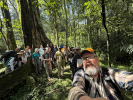SUSTAINABLE TRANSPORTATION
Towards a healthier future for Canadian cities
January 23, 2023
Share

Cities worldwide are looking at how to promote sustainable transportation habits that will benefit both the environment and people’s health. To inform public policies and city planning related to active transportation, a pan-Canadian research project is investigating how sustainable transportation interventions can support health, mobility, and equity outcomes in cities. Queen’s researchers Jennifer Tomasone (School of Kinesiology and Health Studies) and Patricia Collins (Department of Geography and Planning) are members of the research team that recently secured $3M in funding from the Canadian Institutes of Health Research (CIHR) to advance this work.
Co-principal investigator in this study, Dr. Tomasone is an expert in knowledge translation or implementation science, that is, understanding how to effectively put research evidence into practice. An expert in healthy community planning and healthy built environments, Dr. Collins studies how to engage people in more sustainable modes of travel, like public transit or active transportation, and the main barriers to sustainable transportation acceptance.

The project’s multidisciplinary team includes over 50 researchers in public health, environmental sciences, geography, and social sciences across Canada. The group will work with local government partners, city planners, and community groups to document the implementation and outcomes of sustainable transportation interventions in Kingston, Toronto, Montreal, Calgary, Surrey, Halifax, Saskatoon, Guelph, Victoria, and Melbourne (Australia).
Drs. Tomasone and Collins will lead the local component of the project, working with the City of Kingston.
Bicycling networks and speed reduction
The project will focus on All Ages and Abilities (AAA) bicycling networks and speed reduction strategies.
AAA bicycling networks aim to make cycling safe, convenient, and comfortable for people of different ages and abilities, including children, seniors, and new riders. Protected bike lanes and bikeways on small streets or off-street are examples of how to support this type of active transportation, as they create options for individuals who are not comfortable with cycling on major streets.
On the other hand, speed reduction interventions make the roads safer for all users, particularly cyclists and pedestrians who are disproportionately exposed to the hazards associated with excessive speed.
“The speed related conditions of our streets ultimately shape travel mode decisions that we make every day,” argues Dr. Collins. “For example, speed is often a concern in school zones. If parents are concerned about the well-being, safety, and security of their children when they come and go from school, then that incentivizes them to drive their kids to school, instead of walking or biking.”
Both AAA bicycling networks and speed reduction strategies can be built into the design of cities to support mobility for people of all ages and abilities.
Kingston context
Based on Census data (Statistics Canada), Kingston has had high uptake of sustainable transportation modes (e.g., public transit, active transportation, and carpooling) compared to other cities of various sizes across the country. These travel trends are supported by numerous municipal interventions that have helped make the sustainable choice the easy choice.

“The introduction of four express bus routes through its transit revitalization strategy dramatically drove up ridership prior to the pandemic. And, the Active Transportation Master Plan and Active Transportation Implementation Plan signal the City’s strong commitments to improving conditions for active transportation,” says Dr. Collins. “Kingston’s accomplishments to date provide a valuable learning opportunity to support the introduction of sustainable transportation solutions in other jurisdictions across the country.”
Most of the existing research literature on healthy communities and healthy cities focuses on large cities like Toronto, Vancouver, and Montreal. Looking at a city like Kingston is a great opportunity to understand which interventions can be successful in smaller cities, and how.
After completing the case studies in each location, the researchers will work on designing strategies and tools for city planners, policymakers, and other stakeholders. “Our goal is to generate a framework that can be used broadly for all cities to think through when they're proposing or looking to implement one of these two healthy city interventions or another intervention like enhanced public transit for example,” says Dr. Tomasone.
Dr. Tomasone expects the project to garner attention in the context of Canada's National Active Transportation Strategy, launched by the Federal Government in 2021 and that will invest $400 million in active transportation infrastructure in the next eight years.
“This project will allow us to understand where, why, how and in what contexts sustainable transportation interventions have varying success,” says Dr. Tomasone. “Once we understand the barriers that cities face when putting these interventions into practice, our team will then work towards advancing the uptake of the interventions, ultimately enhancing health and equity in our communities.”



